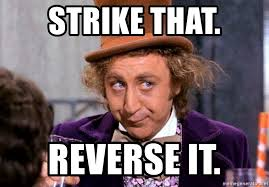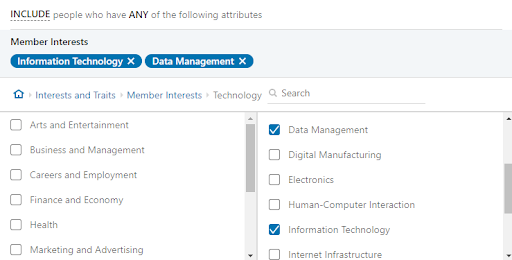For a long time, LinkedIn has been the go-to source for B2B advertising and insights — and it’s about to get way cooler.
Unlike Facebook or Google ads, leveraging ads on LinkedIn lets you serve ads to people based on their professional experience. This allows companies to target users within a certain industry, job role, or seniority.
You literally couldn’t build a better quality B2B audience if you tried. And LinkedIn certainly makes you pay for that. It’s the most premium advertising platform out there, and for many that investment is either too big, or not worth the risk associated with a higher ad cost.
🔎 Related: Are LinkedIn ads worth the cost? (Really?)
Common challenges with LinkedIn ads
Another hesitation companies have with LinkedIn ads is that we’ve only been able to do “passive” advertising. Ads only show up while you’re scrolling through your feed. You aren’t necessarily looking for the product or service that you’re seeing the ad for. The intent isn’t there.
This is where search engine marketing has had the upper-hand. People are actively searching for something and you show them your ads.
I have this conversation all the time:
“Dan, we are getting a lot of leads coming in from search ads, but they are all too small or unqualified. And we are getting high quality leads coming in from LinkedIn, but they are nowhere near ready to buy.”
Search engines give you high-intent users or users with “readiness to buy,” LinkedIn gives you bigger fish with deeper pockets.

Where’s the balance? What’s a digital advertiser to do?
Well, Microsoft has figured it out. And I’m here to tell you that the digital advertising game is about to change. For all of you wondering, “Is LinkedIn worth the cost?” well it’s about to become worth it. Way worth it.
What you need to know about Microsoft’s LinkedIn acquisition
This all goes back to 2016 when Microsoft bought LinkedIn for $26 billion. Why did they do this? To integrate Office 365 and other enterprise software with 260 million professional users.
Their move had nothing to do with their ads platform.
But Microsoft did invest a ton into the network to enhance user experience, reach new audiences, and improve a lot of the things advertisers hated about LinkedIn ads.
And as of last year, they took some of the best aspects of LinkedIn ads and ported them over into their own search engine marketing (SEM) tool — Microsoft Ads aka Bing Ads.
🔎 Related: What's the difference between SEO and SEM?
Microsoft is now offering a new and unique feature that no search engine has been able to: LinkedIn Profile Targeting. This is something that PPC managers and digital marketers have been waiting for for years.
Why does this break traditional SEM?
The LinkedIn Profile Targeting feature allows advertisers to bid differently with LinkedIn profile data that is unique to Bing and never before available.
Traditionally, search engine marketing involves bidding on keywords that users are searching for and showing ads to that person if you win the bid. What is great about using LinkedIn profile data is that you can do the same thing, but only target users of a given company name, industry, or job function.
The bottom line:
Advertisers can now leverage this data to improve their Microsoft Ads targeting and focus more on the users that matter most to their business.
What’s great about Microsoft ads is that you get to advertise to anyone searching on Yahoo, Bing, or DuckDuckGo.
The amount of users on these search engines are a drop in the bucket when compared to Google, but with so many companies using out of the box PCs, a much larger chunk of those B2B professionals you want to target are stuck using Microsoft Edge and Bing anyways.
You’d be surprised how many users reach your site from search engines other than Google.
Why does this matter?
When you are doing search ads, there has always been one major issue:
You have no idea if the person searching for your keywords is qualified.
That's why I hear this on a daily basis:
“We are getting leads in, but they are too small and can’t afford us”
"The leads look good, but the people that convert aren’t high up enough to make the decision to buy.”
What if you could target those same exact users, but filter out all those small fish?
Now you have a user that has expressed need for your product or service, works at a company big enough to afford you, and actually has the seniority required to pull the trigger and buy something.
That’s what I call improving the quality of your ad traffic!
Strike that, reverse it
So yes, this completely changes the SEM game for the better. The LinkedIn Profile Targeting features are still in beta within the US, but should be rolled out on a larger scale soon.
OK, but what about LinkedIn?
So, we know Microsoft pulled some of the best parts of LinkedIn Ads and put them into their search ads tool. But what about reversing that process? Wouldn’t LinkedIn advertisers love to be able to build audiences based on data coming in from MSAds?

Yes, yes we would. And we can.
We are now able to import audiences based on keyword searches and interests into LinkedIn Campaign Manager.
Let’s go back to the issues with LinkedIn. We’ve never been able to show ads to users that have expressed interest in our stuff. It’s passive, and the leads we do generate tend to be very early on in their buyer's journey.
Not anymore.
All of the great audience data we have with Microsoft Ads is available to move into your LinkedIn campaigns.
You will be able to show your LinkedIn ads to people who have searched certain keywords or expressed interest in a certain category.
That means those buyers who expressed interest in your product are no longer needles in the haystack on LinkedIn — you can go after those users specifically.
So, how do you use this?
Well, there are a ton of possibilities here. What we are now targeting is what those LinkedIn members are interested in. So, we can essentially do much better prospecting — something that was a real challenge in the past.
We can use the Interest and Traits information brought over from Bing as a broad reach audience. Then, we can measure the activity our insight tag is bringing in to see what segments of our audience is engaging with us the most.
And once we know that, it’s game on for bottom of the funnel targeting. Alternatively, we can use this information to further qualify our audiences using traditional LinkedIn targeting.
Let's say you sell a medical software that C-Suite executives will use. You can target any CXO member within the healthcare industry, or you can just target the ones already interested in a new software to accomplish exactly what your product does.

The possibilities are endless.
Get creative and think about what users interested in your product are searching for and interested in and apply those to your LinkedIn campaigns.
Before you do anything else, stop and do this
First thing you need to do is look at your Google Analytics acquisition report and see how many users are getting to your site via Bing, Yahoo, or DuckDuckGo.
🔎 Related: The only Google Analytics Checklist you'll ever need
If the number is abysmal, you might not get great use out of these features. But if you’re getting more than 5% of your traffic from these sources, you can afford to do some testing with this.
That has nothing to do with what I’m about to say but it’s important.
So do it.
OK, let's move on to the good stuff
Overall, these features are a huge breakthrough for pairing up search engine marketing with paid social. It’s indicative of how these technologies can work together to better target users, and how easy it is for the platforms to communicate.
With the levels of targeting already available to LinkedIn advertisers and the pace at which they are adding more and more features, there has never been a better time to start advertising on LinkedIn for B2B companies.
The premium cost of the platform can be daunting.
Trust me, though, your users are there.
And now that you are able to target users that have expressed interest in you, you’ll find the quality of the traffic to be worth every penny.


Order Your Copy of Marcus Sheridan's New Book — Endless Customers!

